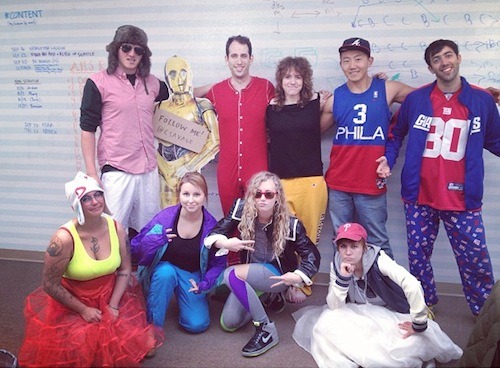As marketers, we’re always searching for a formula for how to be successful — but there’s no formula for this:
http://idonethis.wistia.com/medias/e807mgfdhp?mbedType=iframe&videoWidth=640
While watching Wistia’s recent dance video promoting a feedback survey, I realized that it wasn’t the production, the camera, or the lighting that made the video so compelling, or explained why I watched and shared it with friends. It was the personality of the company’s people shining through.
Wistia offers an incredibly comprehensive guide on how to make incredible marketing videos for your company, but there’s one vital ingredient to successful content marketing that can’t be taught in an instructional video.
Today, it’s company culture that creates marketing messages that spread. It’s that secret sauce that’s impossible to replicate.
A Brief History of Marketing
Psychologist George Silverman pioneered the notion of word-of-mouth marketing, back in the 1970s, long before Twitter and Facebook. At the time, he was conducting focus groups with physicians when he noticed a fascinating and powerful phenomenon.
“One or two physicians who were having good experiences with a drug would sway an entire group of skeptics,” Silverman observed. On the other hand, “a dissatisfied group of ex-prescribers who had had negative experiences” with a drug could also persuade believers in the drug to stop prescribing it.
Word of mouth is incredibly powerful in its ability to persuade, but because communication was much more limited forty years ago, word-of-mouth messages had far less of a propensity to spread. Marketers still had to pay publishers and gatekeepers to distribute word-of-mouth messages on a much larger scale.

With the advent of the internet, and social media in particular, that all changed. Today, messages can spread incredibly quickly around the world, and you don’t have to spend a single penny. Now, the power is distributed among everyone — and the kicker is that people will spread your message for free.
But there’s one catch. You have to have a message worth spreading.
Invest in Culture to Tell a Message Worth Sharing
Early on, Zappos was like any company that had a healthy advertising spend to get its message out. Then CEO Tony Hsieh had an interesting insight that led him to slash their advertising budget.
Hsieh noticed that the most powerful marketing messages came from positive customer experiences. Articles like this one, Check Out The Insane Lengths Zappos Customer Service Reps Will Go To, received tens of thousands of views and spread the brand of Zappos without having to spend a single cent.
“[L]et’s take most of the money we would’ve spent on paid advertising and paid marketing and instead of spending it on that invest it in the customer experience/customer service and then let our customers do the marketing for us through word of mouth,” Hsieh decided.
That worked because Zappos intensely invested in the value of customer service in their company culture. In fact, a core tenet of Zappos’s cultural values is to deliver WOW, a customer experience so over and beyond the norm that it makes you say, well, “WOW!” It’s that ingrained, infectious culture that drives outlier performance to the point that people feel compelled to spread the message about Zappos’s brand themselves.
The Wistia Way

Like Zappos, it’s Wistia’s internal company values that drive its distinctive videos. Wistia co-founder and CEO Chris Savage described the way they do things as: “Go a little over the top, have a lot of fun with it, and express our own excitement.” That’s how you end up with a rap video for a new feature announcement instead of your typical email blast and a dance video asking you to fill out a boring old survey.
They invest in their unique company culture by spending a lot of time fostering it and thinking about the vocabulary they use to communicate internally. It’s not trivial or something that comes without deliberate effort — Savage told me it’s something that they’ve had to “fight for.”
To Savage, this extra effort is worth it. Their internal weirdness and distinctiveness, which radiates in their videos, becomes Wistia’s competitive advantage that drives their formula for making successful videos time and time again.
How to Make Culture Your Company’s Marketing Advantage
The best thing about culture is that it can’t be replicated by copycats. Culture works when it’s authentic, and that which is authentic is highly personal.
Here are some concrete tips on how you can cultivate your company’s distinct and authentic culture.
- Write down your company values.
For Moz founder and CEO Rand Fishkin, writing down company values “defines not only SEOmoz’s strategic differentiation in the highly competitive field of SEO, but also helps to set the standard of quality for all work and content produced.” It unifies your efforts internally and creates something of a universal style guide for your company’s work that explains why people will care about you. - Stay away from paid acquisition early on.
Bonobos founder and CEO Andy Dunn calls paid marketing “crack,” an addictive drug that drives fundraising, top-line revenue, and the appearance of growth, but it gets you no closer to figuring out your core business and who you are fundamentally as a company. It’s actually the pain of the journey without the temporary relief of startup drugs that leads to self-actualization and a core business that drives a value-laden marketing story. - Overcommunicate internally.
As Picasso observed, “when art critics get together they talk about Form and Structure and Meaning. When artists get together they talk about where you can buy cheap turpentine.” So often, when company founders get together, the talk turns from high-level conversation on culture and happiness to the nuts and bolts of how tone gets established internally through the the actual tools and processes your company uses.Companies noted for their culture like Zappos and Wistia don’t just use email alone, they use a multitude of tools and processes, each with a specific purpose to ensure the best internal communication. For instance, at Wistia, they use iDoneThis as an accomplishment list that shows others what they’re working on, they use Yammer for watercooler conversations, and they have weekly standup meetings where they announce their goals for the week. This way, their growing team feels like it did when it was just four guys sitting around a table, and Wistia can more effectively coalesce and foster its unique company personality.
A distinctive, authentic company culture becomes an integral part of its brand. It can be a critical ingredient to your message and story that not drives that powerful modern-day word of mouth but provides internal cohesion. And without some contemplation and communication in your company about how to cultivate an actual culture, drawn from the people and their sense of purpose and values, you won’t get to a message worth spreading.
Liked this post? Subscribe to our free newsletter for more great content on management, productivity, and company culture!
